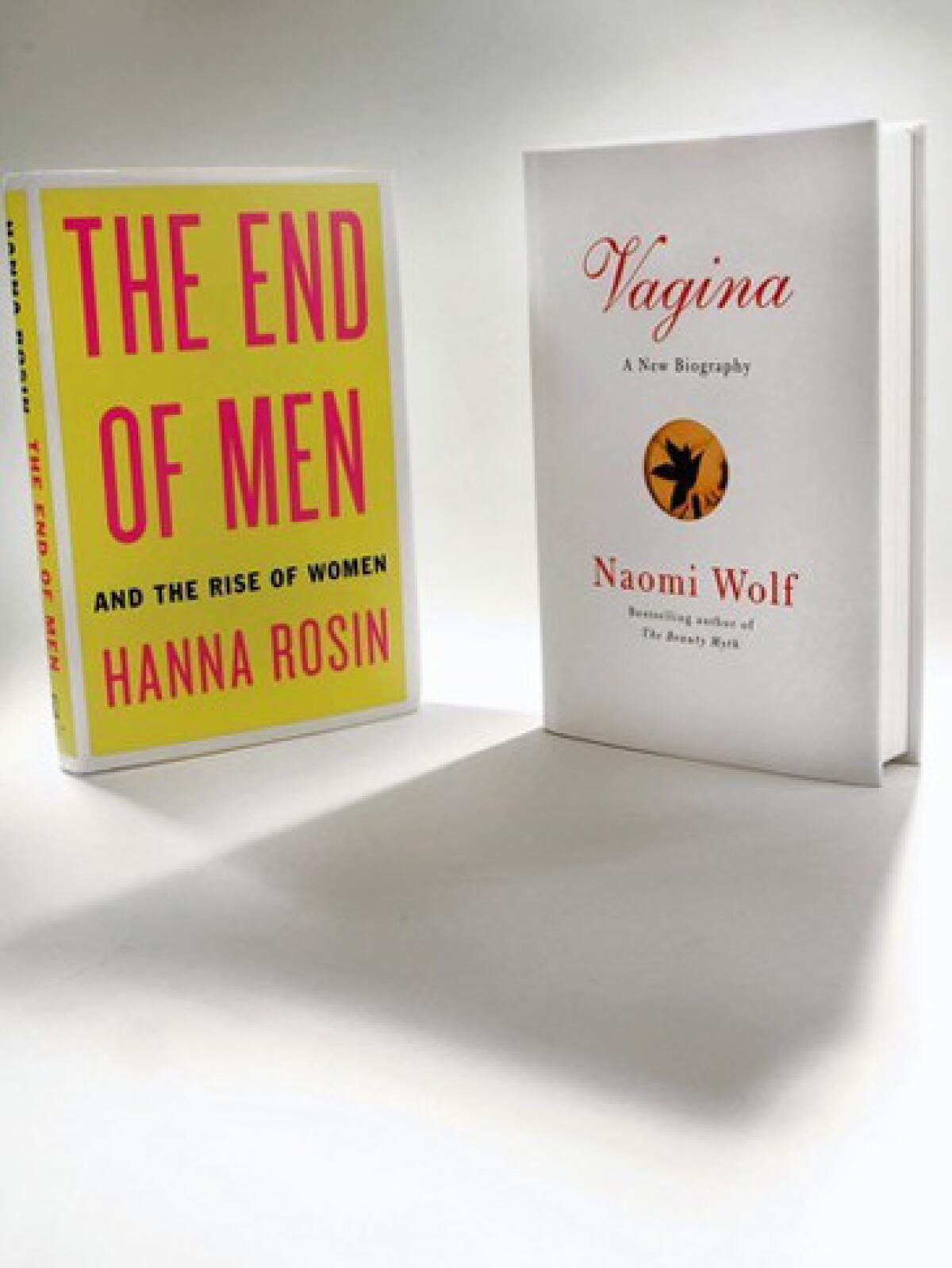Review: Naomi Wolf, Hanna Rosin tackle women in a new century

- Share via
“Vagina: A New Biography” by Naomi Wolf (Ecco / 400 pages / $27.99 )
“The End of Men — and the Rise of Women” by Hanna Rosin (Riverhead / 320 pages / $27.95)
In June, Republican state representatives in Michigan silenced Democratic colleague Lisa Brown for using the V-word during discussion of an abortion bill. Afterward, Rep. Mike Callton refused to utter the word. “What she said was offensive,” he said. “It was so offensive, I don’t even want to say it in front of women. I would not say that in mixed company.”
The discussion of women and their bodies has taken center stage this political season. The feminist group Code Pink protested outside the Republican National Convention wearing vagina costumes, while on the dais, Ann Romney proclaimed, “I love women!” The fight for women’s votes is retro and increasingly heated.
“Vagina: A New Biography,” the forthcoming book by Naomi Wolf, has a title that is both plain and provocative. Since the publication of “The Beauty Myth” in 1991, Wolf has been something of a cultural lightning rod. She has a knack for anticipating the zeitgeist; when she started this book in 2009, she could not have known that conservative politicians would bring renewed attention to the “vajayjay” or that a new generation of writers would give the term fresh currency on television shows such as HBO’s “Girls.”
With “Vagina: A New Biography,” Wolf sets out to make vaginas better understood, ensure they are better tended and secure them a better place in contemporary American society. The book sets itself up as a fact-based inquiry but ends up zigzagging through female writers of the early 20th century and a visit to an African refugee camp.
She began the project after injuring her pelvic nerve — she’s since had corrective surgery — when she saw a medical illustration of nerves branching to different erotic zones in and around the vagina. Wolf had a revelation: Differences in women’s sexual climax could be explained by neurology.
There had been fierce feminist debate over the kind of orgasms women have, and Wolf’s new ideas about neurology led her to think they’re all equally valid. So she began considering what orgasms do to women’s brain chemistry (hello, dopamine), which she associates with feelings of transcendence. She ties all these ideas together with her concept of the Goddess, which she defines as “a gendered sense of self that is shining, without damage, without anxiety or fear.” In her vision, the vagina literally activates “this matrix of chemicals that feel, to the female brain, like the Goddess.”
Wolf discusses her theory that the vagina and brain are connected in specific, semi-spiritual ways with specialists: a psychologist, a Tantric practitioner, sex researchers who work with rats, a “body healer” who does “nonsexual vaginal massage” (a puzzling concept that isn’t explained). A few neurologists are consulted, but OB/GYNs are almost completely absent.
Even a lay reader like myself can see that Wolf’s scientific interpretations are shaky. There are leaps of logic in this deeply flawed book, correlation is mistaken for causation, and she relies heavily on anecdotes instead of research. Most troubling, she presents her theories and goes looking for confirmation. Rather than investigating a question, she’s trying to prove a point.
Which makes Hanna Rosin’s “The End of Men — and the Rise of Women” so refreshing. “As I spent time with [a subject] and dug into the research, I discovered that I had started with the wrong questions,” she tells us in the introduction, letting us know that this is a true inquiry.
Rosin’s book may be the most insightful and readable cultural analysis of the year, bringing together findings from different fields to show that economic shifts and cultural pressures mean that in many ways, men are being left behind.
“Yes, the United States and many other countries still have a gender wage gap. Yes, women still do most of the child care. And yes, the upper reaches of power are still dominated by men. But given the sheer velocity of the economic and other forces at work, these circumstances are much more likely the last artifacts of a vanishing age,” she writes. “The modern economy is becoming a place where women hold the cards.”
Men lost three-quarters of the 7.5 million jobs that evaporated during the 2008 recession, while of the 15 industries that are projected to grow the most over the next decade, 12 are dominated by women. Add to this research demonstrating that women have been culturally adaptable over many decades — Rosin calls them Plastic Women. Whereas men — Cardboard Men — are stuck.
This applies particularly to men in the middle class, which now resembles the lower class: a lot of jobless men and single working mothers. Meanwhile, among the wealthy, two-parent working families are the norm; many are what she calls seesaw marriages, in which the role of primary breadwinner is traded between husband and wife. She’s got the statistics to prove it.
“The End of Men” is buttressed by numbers, but it’s a fascinating read because it transcends them. Rosin sits in kitchens, asks questions and adeptly portrays the individuals inside the statistics. She meets with high-achieving young women and gets a real sense of their sex lives. On a visit to a community college’s night classes, she sees an exhuasted working mother fall asleep between floors in the elevator.
These are well-reported stories; when she reaches for an anecdote, it counts. In Alabama, a former plant manager made a grudging call to the unemployment office — only to hear the voice of his former secretary on the other end of the line.
Rosin’s genius was to connect these dots in ways no one else has for an unexpected portrait of our moment. “The End of Men” is not really about a crisis for men; it’s a crisis of American opportunity.
More to Read
The biggest entertainment stories
Get our big stories about Hollywood, film, television, music, arts, culture and more right in your inbox as soon as they publish.
You may occasionally receive promotional content from the Los Angeles Times.











